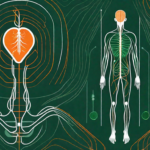Breathing techniques are a simple and effective way to stimulate the vagus nerve and induce a relaxation response in the body. The vagus nerve is a long cranial nerve that runs from the brainstem to the abdomen and plays a key role in regulating the body’s stress response.
The vagus nerve is responsible for transmitting signals between the brain and various organs, including the heart, lungs, and digestive system. It is involved in a wide range of functions, including heart rate, digestion, and immune function.
One of the most important functions of the vagus nerve is its role in the body’s stress response. The vagus nerve is part of the parasympathetic nervous system, which is responsible for calming the body down after a period of stress or arousal. When the vagus nerve is activated, it can help to lower heart rate, blood pressure, and stress hormones, as well as increase feelings of calm and relaxation. Researchers have identified a positive feedback loop between positive emotions, good physical health, and high vagal tone. This means the higher your vagal tone, the higher your mental and good physical health will improve.
There are three states of being: immobilization, mobilization, or social interaction in response to your environment. An invigorating vagal nerve leads you to respond intently. There are several ways to stimulate the vagus nerve and induce a relaxation response in the body. Some people find that deep breathing, meditation, or yoga can help to activate the vagus nerve and promote relaxation. Massage and acupuncture are also thought to stimulate the vagus nerve and may help reduce stress and promote relaxation. In addition to its role in the body’s stress response, the vagus nerve is also involved in a wide range of other functions. It is responsible for controlling the muscles of the larynx (voice box), heart rate variability, and immune response, Through the afferent fibers, it sends information about the internal organs to the brain. The vagus nerve also establishes connections between the brain and the GI (gastrointestinal) tract (1).
What Are The Three Breathing Techniques To Activate A Vagal Response?
1. Diaphragmatic Breathing
Diaphragmatic breathing, also known as belly breathing, is a simple and effective technique that can help to stimulate the vagus nerve and induce a relaxation response in the body. Normal breathing is shallow and does not require the full capacity of your lungs. However, diaphragmatic breathing is a deep breathing exercise that uses the diaphragm to its full capacity and advances the efficiency of the lungs.
How Does The Diaphragmatic Technique Work?
Diaphragmatic breathing can be modified to suit your needs and preferences. For example, you can try taking longer or shorter breaths or focusing on different parts of the breath. Some people find it helpful to count their breaths or use a mantra or other focus words to help them stay present and focused. Experiment with different techniques to find what works best for you. Diaphragmatic breathing can be a powerful tool for relaxation and stress reduction, but it is not a replacement for medical treatment. If you are experiencing severe or persistent stress, anxiety, or other mood disorders.
- To practice diaphragmatic breathing, start by finding a comfortable position in a quiet place. You can lie down on your back or sit in a comfortable chair with your feet planted firmly on the ground. Place one hand on your stomach and the other on your chest
- Take a deep breath through your nose, allowing your stomach to rise as you fill your lungs with air. Exhale slowly through your mouth, allowing your stomach to fall as you release the air. Repeat this process for several minutes, focusing on the movement of your diaphragm and trying to keep your chest as still as possible
Diaphragmatic breathing can be practiced for as little as a few minutes at a time, or for longer periods if desired. Some people find it helpful to set aside time each day to practice diaphragmatic breathing as a way to relax and reduce stress.
In addition to its effects on the vagus nerve,
- Diaphragmatic breathing has several other benefits. It can help to improve respiratory function, reduce anxiety and stress, and improve sleep quality. It is a simple and effective technique that can be practiced by people of all ages and fitness levels. If you are new to diaphragmatic breathing, it may take some time to get the hang of it. With practice, however, it can become a powerful tool for relaxation and stress reduction.
- Diaphragmatic breathing can be especially beneficial for people who struggle with stress, anxiety, or other mood disorders. By activating the vagus nerve, diaphragmatic breathing can help to reduce the body’s stress response and promote feelings of calm and relaxation. This can be especially helpful for people who find it difficult to relax or unwind after a busy or stressful day.
- This breathing technique can also be helpful for people who struggle with respiratory issues such as asthma or chronic obstructive pulmonary disease (COPD). By focusing on the movement of the diaphragm, diaphragmatic breathing can help to improve respiratory function and make it easier to breathe.
Diaphragmatic breathing is a simple and convenient technique that can be practiced almost anywhere. You can do it while sitting in a chair, lying in bed, or even standing up. It requires no special equipment or training, making it an accessible and convenient way to promote relaxation and stress reduction.
2. The 4-7-8 Breathing Technique
The 4-7-8 breathing technique is a simple but powerful breathing pattern that can help to stimulate the vagus nerve and induce a relaxation response in the body.
The 4-7-8 breathing technique, also known as the “relaxing breath,” involves inhaling for a count of four, holding your breath for seven seconds, and exhaling for a count of eight. It is a breathing method created by Dr. Andrew Weil (2). It was created based on the ancient yogic method called pranayama, a practice that helps you gain control over your breathing.
How Does The 4-7-8 Breathing Technique Work?
The 4-7-8 breathing technique is based on the principle of slow, controlled breathing, which has been shown to stimulate the vagus nerve and induce a relaxation response in the body. By slowing down the breath and focusing on the rhythm of the inhale and exhale, this technique can help to reduce stress and promote feelings of calm and relaxation.
- To practice the 4-7-8 breathing technique, start by finding a comfortable position in a quiet place. You can sit in a chair or lie down on your back with your feet planted firmly on the ground. Place one hand on your stomach and the other on your chest.
- Take a deep breath in through your nose and exhale slowly through your mouth. On the next inhale, slowly count to four as you fill your lungs with air. Hold your breath for a seven seconds, then release your breath slowly through your mouth for a count of eight. Repeat this process for several minutes, focusing on the rhythm of your breath and trying to keep your chest as still as possible.
The 4-7-8 breathing technique is easy to learn and can be practiced anywhere, making it a convenient and accessible way to promote relaxation and stress reduction. You may find it helpful to set aside time each day to practice this technique or use it as needed in times of stress or anxiety.
In addition to its effects on the vagus nerve, the 4-7-8 breathing technique has several other benefits.
- Reduce Blood Pressure. Slow deep breathing for six minutes has been shown to reduce heart rate and blood pressure in people who practice it (2).
- Improve the Quality of Sleep. Sometimes, falling asleep after a stressful event can prove very difficult. Practicing this deep slow breathing technique can help you relax and fall asleep.
- Improved Concentration. A study carried out in 2017 showed that people who practiced deep breathing for deep, abdominal breathing performed better with a higher attention span than those who did not.
- Reduce Anxiety and Stress. The body’s response to stress often causes reduced immunity, which can lead to depression and anxiety. Practicing the 4-7-8 breathing technique reduces your level of anxiety.
This breathing technique is a simple and convenient technique that can be practiced almost anywhere. You can do it while sitting in a chair, lying in bed, or even standing up. It requires no special equipment or training, making it an accessible and convenient way to promote relaxation and stress reduction. This breathing method should not be practiced in a setting where you are not prepared to relax. While it does not have to be used for falling asleep, it can put you into a state of deep relaxation (3). So ensure you do not need to be alert immediately after going through your breathing cycles.
The 4-7-8 breathing technique can be modified to suit your needs and preferences. For example, you can try taking longer or shorter breaths or focusing on different parts of the breath. Some people find it helpful to count their breaths or use a mantra or other focus words to help them stay present and focused. Experiment with different techniques to find what works best for you.
3. Alternate Nostril Breathing
Alternate nostril breathing, also known as anuloma viloma or nostril balancing breath, is a simple but powerful breathing technique that can help to stimulate the vagus nerve and induce a relaxation response in the body. The vagus nerve is a long cranial nerve that runs from the brainstem to the abdomen and plays a key role in regulating the body’s stress response. When the vagus nerve is activated, it can help to lower heart rate, blood pressure, and stress hormones, as well as increase feelings of calm and relaxation (4).
How Does The Alternate Nostril Breathing Technique Work?
This breathing method can also be done lying flat on your back (reclining) or propped up on pillows. Reclining will help you fall asleep and is very effective in helping you fall asleep after waking during the night. It is also used to improve respiratory function and reduce anxiety and stress (5).
- To practice alternate nostril breathing, start by finding a comfortable position in a quiet place. You can sit in a chair or lie down on your back with your feet planted firmly on the ground. Place your right hand on your right nostril and your left hand on your left nostril.
- Close your right nostril with your right thumb and take a deep breath through your left nostril. Hold your breath for a moment, then release your right nostril and exhale slowly through your right nostril.
- Inhale through your right nostril, hold for a moment, then close your right nostril and exhale through your left nostril. Repeat this process for several minutes, focusing on the rhythm of your breath and trying to keep your chest as still as possible.
In addition to its effects on the vagus nerve, alternate nostril breathing has some other benefits. Regular breathing practice, helps you to be calmer, more focused, happier, lighter, healthier, and pain-free. Alternate nostril breathing can shift your focus away from the pain sensation. If we focus on the rhythm of our breathing, we can not be focused on the pain. The moment you anticipate pain, you mostly tend to stop breathing and hold your breath. This shows that the human mind processes one thing at once. Holding your breath activates the flight/fight/freeze response, which tends to increase your sensation of pain, anxiety, or fear.
References
- https://en.m.wikipedia.org/wiki/Vagus_nerve_stimulation
- https://www.webmd.com/balance/what-to-know-4-7-8-breathing
- https://www.healthline.com/health/4-7-8-breathing#Other-techniques-to-help-you-sleep
- https://www.stress.org/contentment-connection-easy-ways-to-nourish-your-vagus-nerve-to-become-more-content
- https://www.forbes.com/sites/womensmedia/2021/04/15/what-the-vagus-nerve-is-and-how-to-stimulate-it-for-better-mental-health/?sh=266b70b36250


